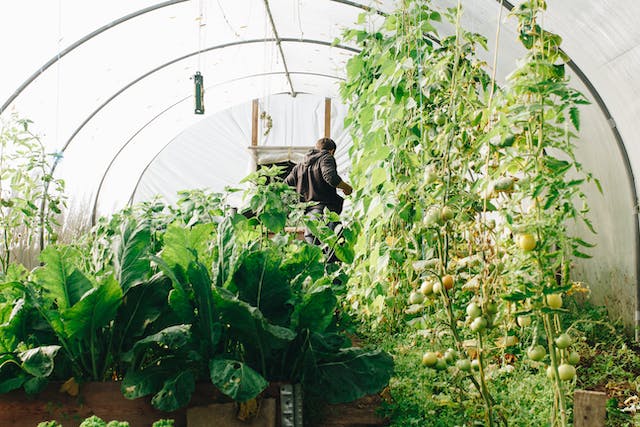Tips for Designing and Building a Successful Large Greenhouse
Posted on 04-12-2023 12:25 μμ

Introduction to Large Greenhouse Design and Construction
Building a large greenhouse can be exciting but requires careful planning and attention to detail. The first step is to determine the purpose of your greenhouse and what you want to grow in it. This will help you design a space that meets your specific needs. It would be best to consider your area's climate and weather conditions to ensure your greenhouse is built to withstand them.
Choosing the Right Location for Your Large Greenhouse
The location of your large greenhouse is crucial to its success. Choose a spot with plenty of sunlight throughout the day and good drainage. Avoid areas near trees or other structures that may block sunlight or cause damage to the greenhouse. Additionally, make sure there are no underground pipes or wires that could interfere with construction.
Selecting the Best Materials for Building a Large Greenhouse
When selecting materials for building a large greenhouse, quality is critical. Look for durable materials that can withstand harsh weather conditions and adequately support plants. Consider using aluminum frames, which are lightweight and robust, and polycarbonate panels, which offer excellent insulation and protection from UV rays.
Tips for Maximizing Space in Your Large Greenhouse
One of the challenges of building a large greenhouse is maximizing space while still providing enough room for plants to grow. Use vertical space by installing shelves or hanging baskets, and group plants together based on their growing requirements. You can also install a movable bench system to allow easy access to plants and optimize space utilization.
Maintaining a Successful Large Greenhouse
Regular maintenance is essential to maintain a successful large greenhouse. Keep the interior clean and well-organized, and check for any signs of pests or diseases. Monitor temperature and humidity levels to ensure they remain within optimal ranges for plant growth. Finally, don't forget to water your plants regularly and apply fertilizer as needed.
Conclusion
Designing and building a successful large greenhouse takes time and effort, but with careful planning and attention to detail, you can create a beautiful and productive space for growing plants. Following these tips, you can build a greenhouse that meets your needs and provides ample space for plants to thrive.
Inside Look at Some of the Largest Greenhouses in the World
Greenhouses are becoming increasingly popular as people seek ways to grow their food and plants. Large greenhouses, in particular, offer a range of benefits that make them an attractive option for both commercial and hobbyist gardeners. In this article, we'll take an inside look at some of the largest greenhouses in the world and explore what makes them so unique.
Introduction to Large Greenhouses
Large greenhouses typically measure 10 feet or more in height and width. These structures allow gardeners to grow crops year-round, even in colder climates where traditional outdoor gardens are impossible. The size of these greenhouses also allows for larger plants, such as trees and vines, to be grown.
The Benefits of Building a Large Greenhouse
There are several advantages to building a large greenhouse:
1. Year-Round Growing - With a large greenhouse, you can grow crops year-round, regardless of the weather outside. This means you can enjoy fresh produce even during the winter months.
2. Space - A more prominent space allows for bigger plants to be grown, including fruit trees and grapevines. It also provides ample room for storage and workspace.
3. Efficiency - Larger greenhouses can be designed efficiently, allowing for better airflow, lighting, and temperature control.
4. Commercial Use - Large greenhouses allow commercial growers to scale up production and increase profits.
Inside Look at Some of the Largest Greenhouses in the World
One example of a massive greenhouse is the Oasis Agro Farm in Qatar. At over 5 million square feet, it's one of the most enormous greenhouses in the world. Another impressive structure is the Eden Project in Cornwall, England. Built into an old clay mine, it spans over 7 acres and features biomes worldwide.
Tips for Designing and Constructing a Large Greenhouse
If you're considering building a large greenhouse, there are a few tips to keep in mind:
1. Location - Choose a location that receives plenty of sunlight but is protected from harsh winds and extreme temperatures.
2. Materials - Select high-quality materials that withstand wear and tear over time.
3. Ventilation - Ensure your greenhouse has proper ventilation to prevent excess heat buildup and maintain ideal humidity levels.
4. Lighting - Consider installing supplemental lighting to extend growing seasons and improve crop yields.
Managing a Successful Large-Scale Greenhouse Operation
Running a successful large-scale greenhouse operation requires careful planning and management. Here are a few tips to help you get started:
1. Develop a business plan - Determine your goals, target market, and financial projections before breaking ground on your greenhouse.
2. Hire experienced staff - You'll need skilled workers who can manage irrigation systems, monitor plant growth, and handle pests and diseases.
3. Monitor environmental conditions - Keep track of temperature, humidity, and other factors that affect plant growth and adjust accordingly.
4. Stick to a schedule - Establish a routine for watering, pruning, and harvesting crops to ensure consistency and quality.
Common Mistakes to Avoid When Building or Operating a Large Greenhouse
Here are a few common mistakes to avoid when building or operating a large greenhouse:
1. Poor construction - Using subpar materials or failing to insulate your greenhouse correctly can lead to structural issues and energy loss.
2. Overwatering - Too much moisture can cause root rot and other problems, while too little can stunt plant growth.
3. Pest infestations - Failing to implement effective pest control measures can result in costly damage to your crops.
4. Inefficient layout - Not optimizing your greenhouse layout can waste valuable space and make it challenging to access tools and supplies.